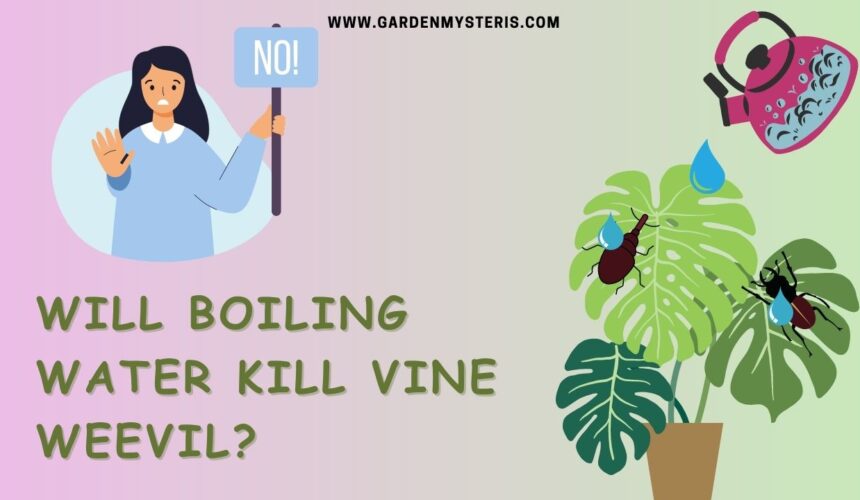Will boiling water kill vine weevil? If this is what you are looking for, my answer is a partial yes. Boiling water can be a handy method to kill vine weevils, especially if used on the soil around the plants where the larvae reside.
However, keep in mind that boiling water can also harm desirable plants and beneficial soil organisms, so it should be used with caution. Now, get ready to dive into the depth of this article.
What Is Vine Weevil?
The vine weevil (Otiorhynchus sulcatus) is a common garden pest that belongs to the family Curculionidae. Adult vine weevils are small, flightless beetles with a dark color and distinctive markings on their elytra (wing covers).
They are about 8-10 mm (0.3-0.4 inches) in size. The larvae, also known as white grubs, are legless and C-shaped, and they feed on plant roots, causing significant damage to a wide range of plants.
Is Vine Weevil Bad for Plants?
Yes, vine weevils are considered bad for plants. Both the adult weevils and their larvae can cause damage to a wide range of plants, particularly ornamental plants, and crops.
Adult vine weevils feed on the edges of leaves, creating characteristic notches along the leaf margins. While this usually causes only minor damage to the plant, it can be unsightly and affect the plant’s overall appearance.
However, it is the larvae of vine weevils that pose a more significant threat to plants. The larvae, also known as white grubs, are C-shaped, legless, and feed on the roots of plants. They cause root damage, leading to weakened growth, wilting, and sometimes even the death of the affected plants.
Because of their ability to harm plants at different stages of their life cycle, vine weevils are considered pests in gardens and landscapes. Gardeners and growers often implement various control methods to manage vine weevil populations and protect their plants from damage.
Will Boiling Water Kill Vine Weevil?
Yes, boiling water can be an effective method to kill vine weevils, especially when used on the soil where the larvae reside. When you pour boiling water over the soil, it can scald and kill the vine weevil larvae present in the immediate area.
The larvae of vine weevils, also known as white grubs, are typically found in the soil, where they feed on plant roots. Boiling water applied to the infested soil can help to disrupt the life cycle of the weevils and reduce their population.
However, it’s important to note that while boiling water can be effective against vine weevils, it can also harm desirable plants and beneficial soil organisms. Therefore, this method should be used with caution and targeted specifically to the affected areas.

When using boiling water to control vine weevils, be sure to focus on the soil around the infested plants and avoid pouring the water directly onto the plant foliage. Additionally, consider combining boiling water treatment with other control methods to effectively manage vine weevil populations and protect your plants.
You can also check out, Roly Poly Vs Pill Bug. It will surely debunk some of your misconceptions about gardening.
How to Get Rid of Vine Weevil from Plants?
To get rid of vine weevils from plants, you can employ several effective control methods. Combining different strategies can increase the chances of successfully managing these pests. Here’s a step-by-step guide on how to get rid of vine weevils from your plants:
Step 1: Inspect Your Plants
Regularly inspect your plants for signs of vine weevil infestation. Look for notched leaves caused by adult weevils feeding, wilting, or stunted growth, and the presence of C-shaped white grubs in the soil around the roots.
Step 2: Handpicking
In the evening, when vine weevils are more active, manually remove the adult weevils from plants. Place a cloth or sheet under the plant and gently shake the branches to make the weevils fall onto the cloth. Dispose of them away from the garden.
Step 3: Biological Control
Introduce beneficial nematodes (e.g., Steinernema kraussei) to the soil. These nematodes are natural predators of vine weevil larvae and can help reduce their population without harming other beneficial organisms.
Step 4: Soil Drench with Insecticides
Apply systemic insecticides containing imidacloprid or acetamiprid as a soil drench. The plant absorbs the insecticide, and when the larvae feed on the roots, they ingest the poison, leading to their death. Follow the instructions on the product label and use insecticides judiciously.
Step 5: Sticky Traps
Place sticky traps around affected plants to catch crawling adult weevils. The traps can help reduce the adult population and disrupt their breeding cycle.
Step 6: Physical Barriers
Create physical barriers around plants using materials like copper tape or collars to deter adult weevils from climbing up to lay eggs.
Step 7: Inspect New Plants for Vine Weevil
Before introducing new plants into your garden, inspect them carefully for any signs of vine weevil infestation. Quarantine new plants if needed to prevent the spread of the pests.
Step 8: Improve Soil Drainage
Vine weevil larvae thrive in moist soil. Improving soil drainage can make the environment less suitable for their development.
Step 9: Avoid Overwatering
Overwatering can create favorable conditions for vine weevils. Water plants only as needed and avoid excessive moisture in the soil.
Step 10: Encourage Natural Predators
Create a garden environment that attracts natural predators of vine weevils, such as birds, toads, and ground beetles. These predators can help keep the weevil population in check.
Remember that vine weevil control is an ongoing process, and it may take some time and consistent effort to effectively manage their population. By employing these methods and regularly monitoring your plants, you can significantly reduce the impact of vine weevils on your garden.

FAQ
Can I use boiling water in combination with other control methods for better results?
Yes, combining boiling water treatment with other control methods, such as biological control, sticky traps, and soil drenching with insecticides, can create a more comprehensive approach to effectively get rid of vine weevils from your plants and garden.
How often should I use boiling water on my plants to control vine weevils?
The frequency of boiling water treatment depends on the severity of the infestation. Using it as a part of an integrated pest management approach, apply boiling water when you observe signs of vine weevils or their larvae.
When is the best time to apply control measures for vine weevils?
It’s best to apply control measures in the late summer or early autumn when the adult weevils are actively laying eggs. Treating the soil at this time can help disrupt the life cycle and reduce future infestations.
Thanks for reading. You may also check, Will Epsom Salt Kill Plants?







[…] Have you checked out my last article yet? If not then go through the article called Easy ways to get rid of Vine Weevil. […]